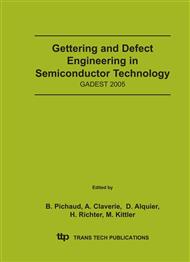p.303
p.309
p.315
p.321
p.327
p.333
p.339
p.345
p.351
Electrical Passivation of Silicon Wafers
Abstract:
Surface passivation in silicon wafers is investigated by contactless photoconductance measurements. It is shown that the deposition of a-Si:H layers on top of c-Si wafers leads to passivation of the c-Si surface. Passivation by Si3N4 of the p c-Si surface is at least partially due to the depletion layer at the interface. The separation of excess charge carriers by the depletion field is responsible for a relatively slowly decaying part of the signal not directly related to bulk recombination. An HF dip is not sufficient for an appropriate passivation of p c-Si but immersion in I2/ethanol solution is promising.
Info:
Periodical:
Pages:
327-332
Citation:
Online since:
December 2005
Authors:
Keywords:
Price:
Сopyright:
© 2005 Trans Tech Publications Ltd. All Rights Reserved
Share:
Citation:


